Review: Eduard 1/48 Fw-190A-8
The Fw-190A-8 is the most-produced Fw-190 sub-type with over 6,655 A-8 airframes produced from March 1944 to May 1945. A-8s were manufactured in at least eight factories during its production run. The aircraft was a development of the previous A-7, with the same increased armament of two 13mm machine guns in the fuselage rather than the previous 7.7mm weapons of the A-1 through A-6 sub-types. With additional armor plate installed and other technical changes, the days of the lightweight “dogfighter” were gone; the primary target of this Wurger was Allied bombers, not fighters. The type was powered either by the standard BMW 801 D-2 or the 801Q,also known as 801TU. The 801Q/TU, with the "T" signifying a Triebwerksanlage unitized powerplant installation (a “power egg”) specifically for single-engined aircraft, was a standard 801D with improved, thicker armor on the front annular cowling, which also incorporated the oil tank, upgraded from 6 mm on earlier models to 10 mm. The pitot tube was moved from its previous position outboard of the right wing gun to the right wingtip.
Other changes introduced in the Fw-190A-8 included the C3-injection Erhöhte Notleistung emergency boost system, which for a short time could raise power to 1,953 hp. This system operated by spraying additional fuel into the fuel/air mix, cooling it, thus allowing higher boost pressures, but at the cost of much higher fuel consumption. The A-8/R4 utilized the GM-1 nitrous oxide boost system.
From the A-8 on, Fw-190s could be fitted with a new paddle-bladed wooden propeller, easily identified by its wide blades with curved tips. A new bulged main canopy, more like the P-51's Malcolm hood than a bubble canopy, which provided improved vision sideways and aft, had been developed for the F-2 ground attack model, but was often seen on A-8s, F-8s and G-8s.
A new internal fuel tank with a capacity of 30 US gal was fitted behind the cockpit, forcing the radio equipment to be moved forward to just behind the pilot. A fuel filler was added to the port side, below the rear canopy and a rectangular radio access hatch was added to starboard. A large round hatch was incorporated into the lower fuselage for installation of the new C-3 tank, and the pilot's oxygen bottles were moved aft and positioned around this hatch.
Other changes included an ETC 501 under-fuselage rack which was mounted on a lengthened carrier and moved 200 mm (8 in) further forward to help restore the center of gravity of the aircraft. Some units, particularly JG 26, developed a smaller, lighter carrier for the drop tank, which distinguished them from other units. This central fuselage formed the basis for all later variants of the Fw-190 and the Ta-152 series. The Morane "whip" aerial for the Y-Verfahren (IFF) was fitted under the port wing, just aft of the wheelwell.
Pips Priller Faces Down The Normandy Invasion:
By the end of May, 1944, JG26 was a much different organization than it had been at the turn of the New Year. After five months of increasingly-difficult battles with the 8th Air Force during Operation Argument - the strategic bombing campaign designed to knock out the Luftwaffe prior to the invasion of Europe, the Geschwader had faced increasing numbers of American fighters, particularly the superlative Mustang. Located as they were at the Western European point of entry for nearly every 8th Air Force mission against Germany, the pilots of the three Gruppen flew multiple missions against the USAAF formations, and suffered attrition accordingly. Many notable leaders, among them III Gruppe's Kommandeur “Wutz” Galland - youngest brother of the redoubtable Adolf - had been lost in the battles, as well as other experienced Staffel and Rotte leaders. The new pilots who came to the Geschwader - called Nachwuchs (new growth) - suffered from increasingly-abbreviated training and were really not qualified to go up against their Allied opponents.
Thus, with a weather forecast for the first week in June that seemed to preclude any possibility of the Allied invasion every German knew would come sooner rather than later that summer, Geschwader Kommodore Oberst Josef “Pips” Priller - the leading German experte on the Channel Front - felt safe in giving some of his pilots time off, sending II Gruppe to Mont de Marsan near Biarritz for a week's leave. I and III Gruppen, which were based on the Pas de Calais, directly in what it was expected would become the battlefield, were ordered to move inland on June 5, with I Gruppe to be based at Reims and III Gruppe at Nancy. Their ground echelons were still on the road as dawn came on June 6, 1944 when Priller was awakened by the phone in his Lille command post.
The orders from 5th Jagddivision were for him to move the Geschwader headquarters immediately to Poix, to the rear of the anticipated invasion site on the Pas de Calais, since what looked like the Allied invasion had begun a few hours earlier with mass landings of paratroopers on the Cherbourg peninsula and inland from the Normandy beaches and he needed to move into the combat zone.
The dawn skies were a leaden grey at 0800 as Priller and his longtime wingman, Unteroffizier Heinz Wodarczyk, mounted their two Fw-190A-8s and prepared to take off for a reconnaissance of the invasion beaches. The initial Luftwaffe response to the Normandy Invasion was underway.
With Wodarczyk sticking close, Priller headed west at an altitude of 100 meters. East of Abbeville, he looked up and saw several large formations of Spitfires flying through the broken cloud base. Near Le Havre, Priller climbed into the cloud bank hanging at 200 meters, turning northwest.
A few moments later, the two broke out of the clouds, just south the British invasion beach code-named Sword. Priller only had a moment to stare out to sea, where the largest naval force ever assembled in history was just offshore. He could see the wakes of the inbound invasion barges as they approached the beaches for as far as he could see in the hazy weather.
With a shouted “Good luck!” to Wodarczyk, Priller winged over into a dive above Sword Beach, his airspeed indicator climbing above 400 m.p.h. Dropping to an altitude of 50 feet, Priller roared toward Sword Beach, followed closely by Wodarczyk.
British troops dove for cover while the ships offshore opened a barrage of anti-aircraft fire so loud that those on the ground had trouble hearing sound of the 8 20mm cannon and 4 13mm machine guns with which Priller and Wodarczyk opened fire as they flashed overhead, unscathed by the fleet's fire.
In a moment, the only appearance by the Luftwaffe over the Normandy beaches on the first day of the invasion was over. The two Fw-190s zoomed back into the cloud bank and disappeared. Priller and Wodarczyk had just flown the best-known mission in the entire history of JG 26, due to its later inclusion in Cornelius Ryan's book “The Longest Day” and the movie made from it.
By that afternoon, I and III Gruppen had flown the majority of the 172 sorties flown by the Luftwaffe in the invasion sector on June 6 - compared to the 14,000 sorties flown that day by the Allied Air Forces - while II Gruppe flew across France in time to fly a mission over Normandy in the last light of day, then operated from Guyancourt aerodrome outside Paris.
By the evening of June 7, there were only six Jagdgeschwadern in Germany, with 17 having flown into northwestern France to oppose the invasion. Had all units been at full strength, this would have been a force of over 1,000 fighters, which might have had an impact on the battle. Unfortunately, with the losses suffered over Germany in the preceding months and the disorganization of the move from Germany to France, only 289 fighters were listed as operational at sundown of the second day of the invasion. Over the course of the next two months, what was left of the flower of the Jagdwaffe would die over Normandy, outnumbered by odds of 100:1 and outflown by better-trained and more experienced Allied pilots.
On June 7, Priller scored his 97th and 98th victories, a P-47 and P-51 respectively, while pilots of I and II Gruppen scored 8 for two losses. The next day, after the weather lifted, Priller led a strafing mission of 11 Focke-Wulfs from I Gruppe against the beaches which only scored the “destruction”of 15 crashed gliders. On June 10, Priller scored #99, a P-38 in a low-level dogfight.
On June 12, Priller was ordered to make an early morning sweep northwest of Caen. Leading Fw-190s of II/JG 26 and III/JG 54, and Bf-019s of III/JG 26, Priller was ordered to change course and attack several formations of heavy bombers heading inland. He dived through a formation of B-17s, firing at several to no effect. In the distance he spotted a formation of B-24 Liberators and turned toward them.
The B-24s of the 492nd Bomb Group had almost no warning as the German formation roared through them. Priller opened up on the B-24 in the outboard position of the first vee, getting strikes in the cockpit and on the two left engines. He dived away as he saw the bomber fall away from the formation with three engines afire.
Priller headed inland as the B-24 turned for the beach, straining for allied territory. Two engines were dead and a third was aflame. As the third engine failed, the navigator reported they were over allied territory and bailed out. The pilot held for another few minutes until the fourth engine quit, and then the rest bailed out. The navigator had gone too soon, and was picked up by German troops to become a POW, while the others landed safely behind Allied lines. In a twist of fate, the navigator's mistake meant he would survive the war, since the rest of the crew died three weeks later in a crash back at base.
The B-24 was Priller's 100th victory, all scored on the Western Front in the Battle of France, the Battle of Britain, and the Channel Front battles. On landing, his men congratulated him, but he was more interested in the letter from home, in which his wife told him his eldest child would be born in a week. At the end of June, he reported to Hitler's Wolfschanze to be awarded the Swords to the Knight's Cross; he was the second and last JG 26 pilot to be so decorated.
Priller scored one more victory at the end of 1944 and survived the war, leaving JG 26 shortly after Operation Bodenplatte to become Inspector of Day Fighters in the West. His record of five years' continuous combat service on the toughest front of the war was unequaled by any other pilot.
THE KIT
Eduard has over the past two years re-released a series of Fw-190A model kit that are simply the best Fw-190A kits available in 1/48 scale. Unlike their previous “fiddly” Wurger kits that were really difficult to assemble closed up, these kits are the epitome of “buildable,” making up as a “curbside” model with only the canopy having an option of being open or closed.
Surface detail on these kits is superb. I did not realize until I wrote the list of physical changes in the Fw-190A-8 above that Eduard's various kits have only the open hatches and gas points appropriate for that sub-type. No other series of Fw-190As from any manufacturer does that. There is one thing: while Dragon used only the seat that was appropriate from the A-8 on in all their kits, Eduard uses only the early seat in all of theirs. It's a small matter, but if you have a Dragon seat in your spares box, and if accuracy is important to you, you want to substitute that seat for the kit seat.
Decals cover five different aircraft, only one of which has been done before by any other manufacturer, that being Option C, the Fw-190A-8 of JG 300 flown by Unteroffizier Ernst Schroeder. I opted for Priller's more well-known aircraft due to a coincidence of finding the Aeromaster sheet with his airplane on it at the LHS two weeks ago, and the kit's arrival the week of the 75th anniversary of his famous flight. Otherwise I would have used the kit markings, any of which are excellent.
CONSTRUCTION
I've said it before, I'll say it again about these kits: take your time and follow the instructions, and a superb result is guaranteed. The only “fiddly” thing to do with this kit is to lightly scrape the extended inner cannon cover where it sticks up, to insure an easy fit for the fuselage.
Construction starts with the cockpit, and the photoetch parts supplied in the Profipack kit make this assembly easy once you have painted it Dark Grey RLM 66. When complete, I assembled the cockpit into the fuselage, and glued the fuselage together.
The wings are equally easy, with only a bit of “fiddly” in assembling the wheel wells, but there is nothing difficult there. I finished by painting the wheel wells in RLM02.
I brought the fuselage and wing subassemblies together, then finished by attaching the cowling ring, and finally the horizontal stabilizers, which I posed with a “droop” after cutting off the locating pins.
One thing to be sure of here is to check you are using the correct aileron parts and correct elevator and rudder parts for the A-8, which are different in detail from those used for the earlier versions, which are there on the sprues.
I scratched a drop tank pylon from Evergreen plastic, referring to the closeup photo I found of the installation on Priller's airplane.
COLORS & MARKINGS
I pre-shaded the model, then applied white over the areas I would then paint yellow. When these were dry, I masked off the rudder and lower cowling panels. The model was then painted with my Tamiya mixtures of RLM76 Lichtblau, RLM75 Grauviolett and RLM74 Grunviolett in a standard Fw-190A-8 pattern chosen from the kit's painting instructions.
I used the kit decals for all the stenciling, which I applied first, then the Aeromaster decals for the national insignia and personal markings.
After setting up overnight, I applied a coat of clear “semi-flat” finish (not quite fully flat, this was a well-maintained airplane). I applied some exhaust staining, then attached the landing gear and prop, unmasked the canopy and posed it open.
CONCLUSIONS
These Eduard Fw-190s are my favorite kits for buildability and an excellent result. They're just superb. You can't go wrong with them, and the profipack kits with the extra details and excellent decals are a great value. Recommended for any modeler.
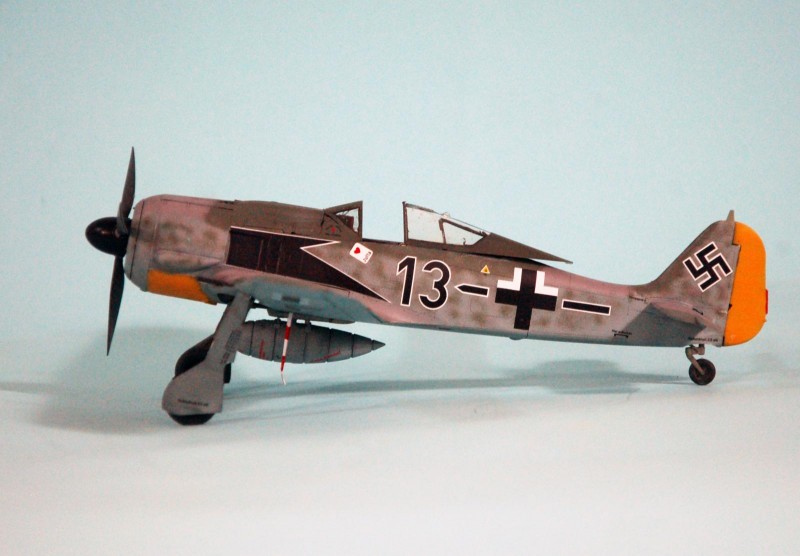
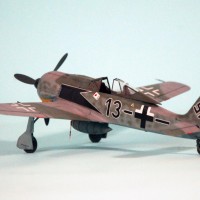

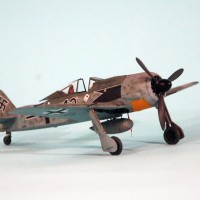
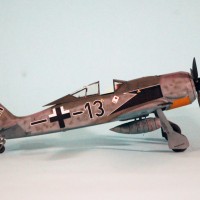
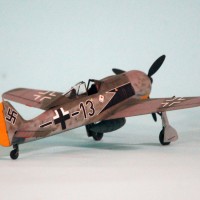
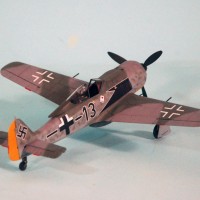
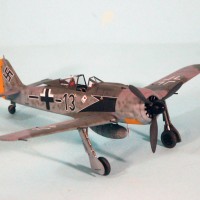
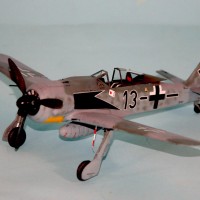
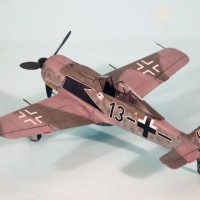
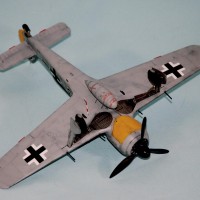
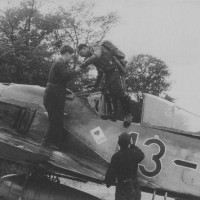
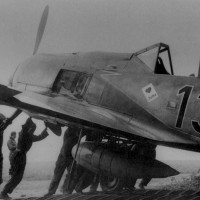
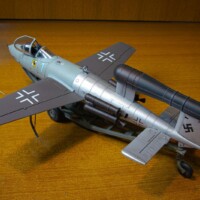

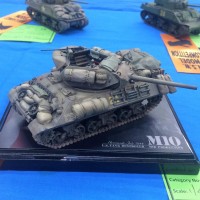

Probably the most build kit of an 190 A-8 is Pips Priller mount. You did a great job with this one Tom, the fact that you have a few of these “new” moulds under your belt shows in the solid build. This version, when the weekend box comes along, is on my wish list.
Tom,
How easy is it to convert these kits to a wheels-up build?
Since the gear door fits in the wing, probably not that hard.
Superb job as usual Tom. Really like it!
Great job on this Tom!
Nice presentation as always, TC.
Nice work!
Most excellent, Tom. Nice build and I really love the tour historical write up. Priller’s D-Day run was one of my favorite memories of when I first saw “The Longest Day” in 1962.
Great build, Tom. The accompanying story was also very interesting. Thanks for sharing.
James Robinson said it, “excellent as usual”. Although usually there’s an inherent problem when excellence becomes the benchmark, these posts keep delivering, Tom.
‘Liked’ - as ever.
Pretty much everybody here is operating on that benchmark, and those who are still approaching it are getting lots of good ideas to advance the cause.
Actually, I said "Superb", but we should not worry about that. In my years of Architecture school and many years of Woodworking, Photography and other endeavors I have found one thing to be true! Perfection is unobtainable in the eyes of the creator...Near perfect is the best that we can achieve. I think Tom achieves this on a normal occasion with his models. I tip my hat to you Tom. Well done.
Yes, we are definitely our own severest critics. I can always point out what wasn't achieved, despite the congratulations. But that's what it's all about - who learns anything from success?
I'm glad that Eduard listened and fixed the issues (especially the wings) with their FW-190 kits. After I fought and slogged thru two, I wasn't planning on getting another.
"Would you mind very much, telling me where the invasion is?" Hahahahaha
Or something like that. Great model and story.
Good to see you back, old friend.
🙂 … Greetings … 🙂 :
Nice looking build Tom.
Nice to see this new Wurger built up Tom.
Lovely work!
I will have to get one of these.
Anyone who hasn't gotten one of these new Eduard Wurgers has missed the best series of fantastic plastic scale models out there. Eminently buildable to a superb result, lots of possibilities.
Beautiful model Tom. Your word pictures are always great reading: they give the model character & 'personality' as well. I have a couple of the earlier Eduard issue, so I must get my act together after reading your post.
Those earlier releases are truly terrible. The best thing to do with them is save the decals and the photoetch and turn them into parts supplies for other kits. These new kits only share subject matter with the old. Just for comparison, I am doing the Fw-190D-11 and the effort to get a closed-up model like one of the new ones is a real effort,
Another great-looking 190 Tom.
I have a question about this Eduard 1/48 Fw-190A-8 kitt, I have studied the instructionsmanual of this kitt on the Supper hobby site, where you can buy modelkitts and I have discovered that the propeller can't turn, is this true, did I overlooked something, can somebody tell me? I am asking this because I want to buy this kitt in the future.
You can turn the prop.
Great "Ritta"! I wish I will made the same in 1:72 scale.